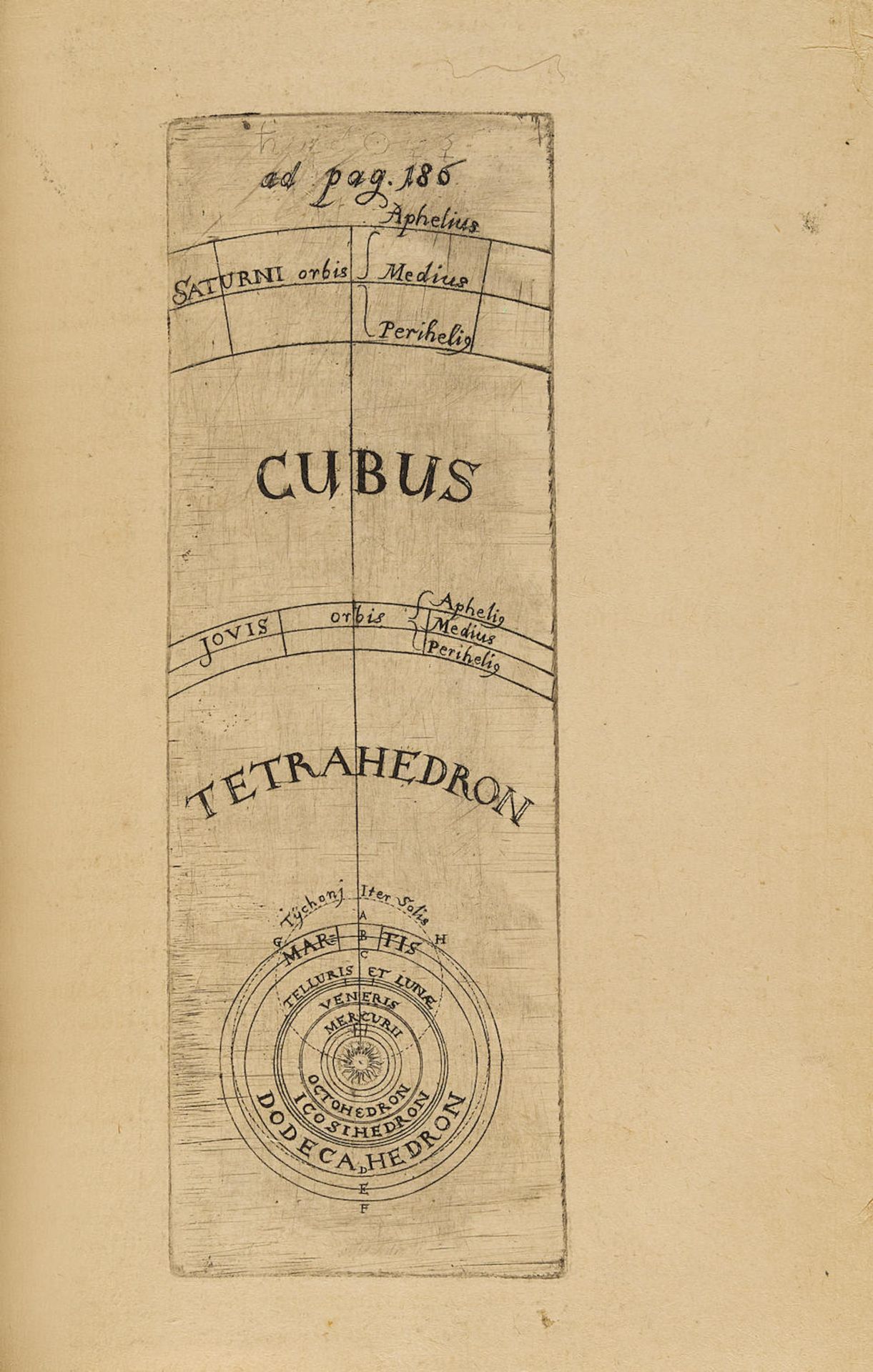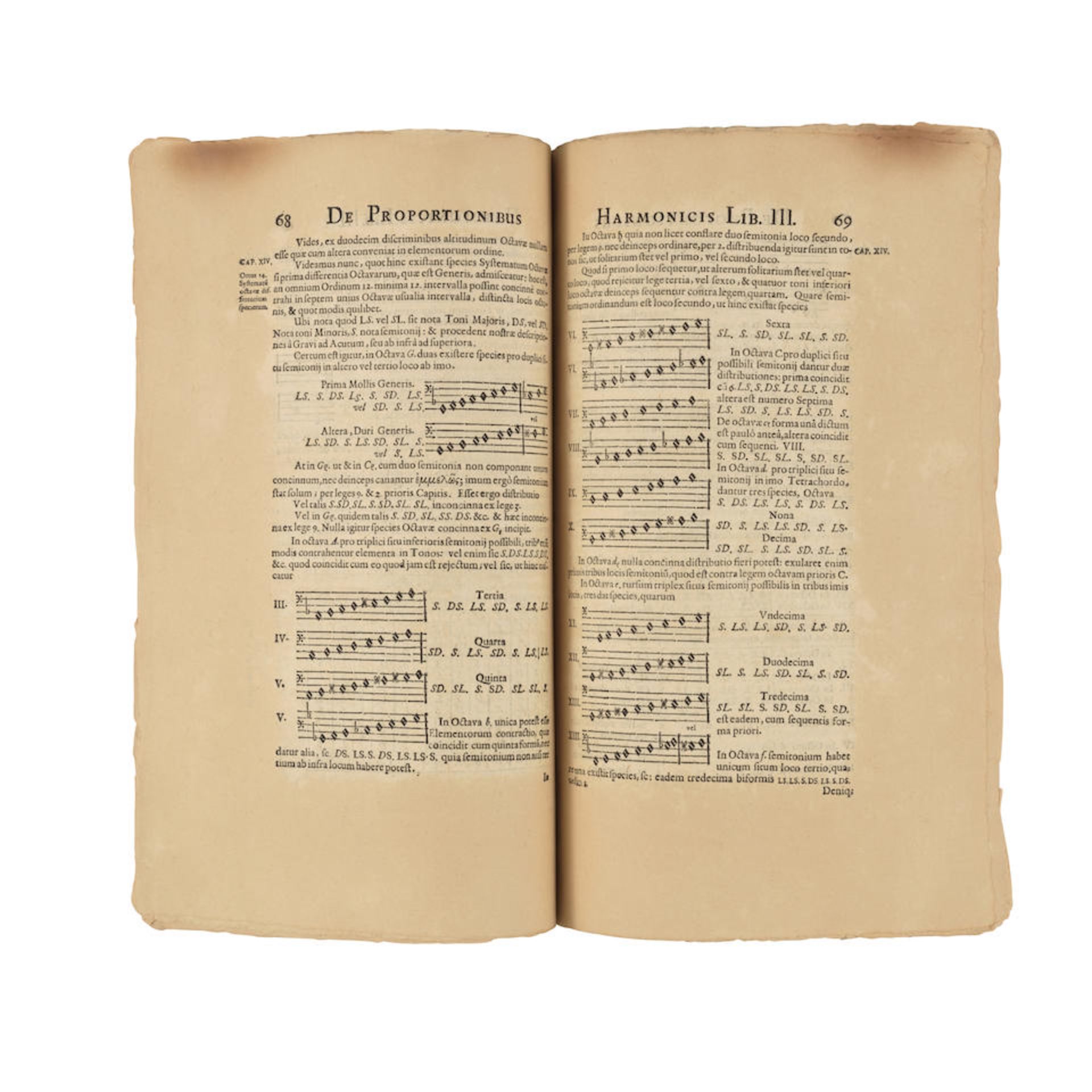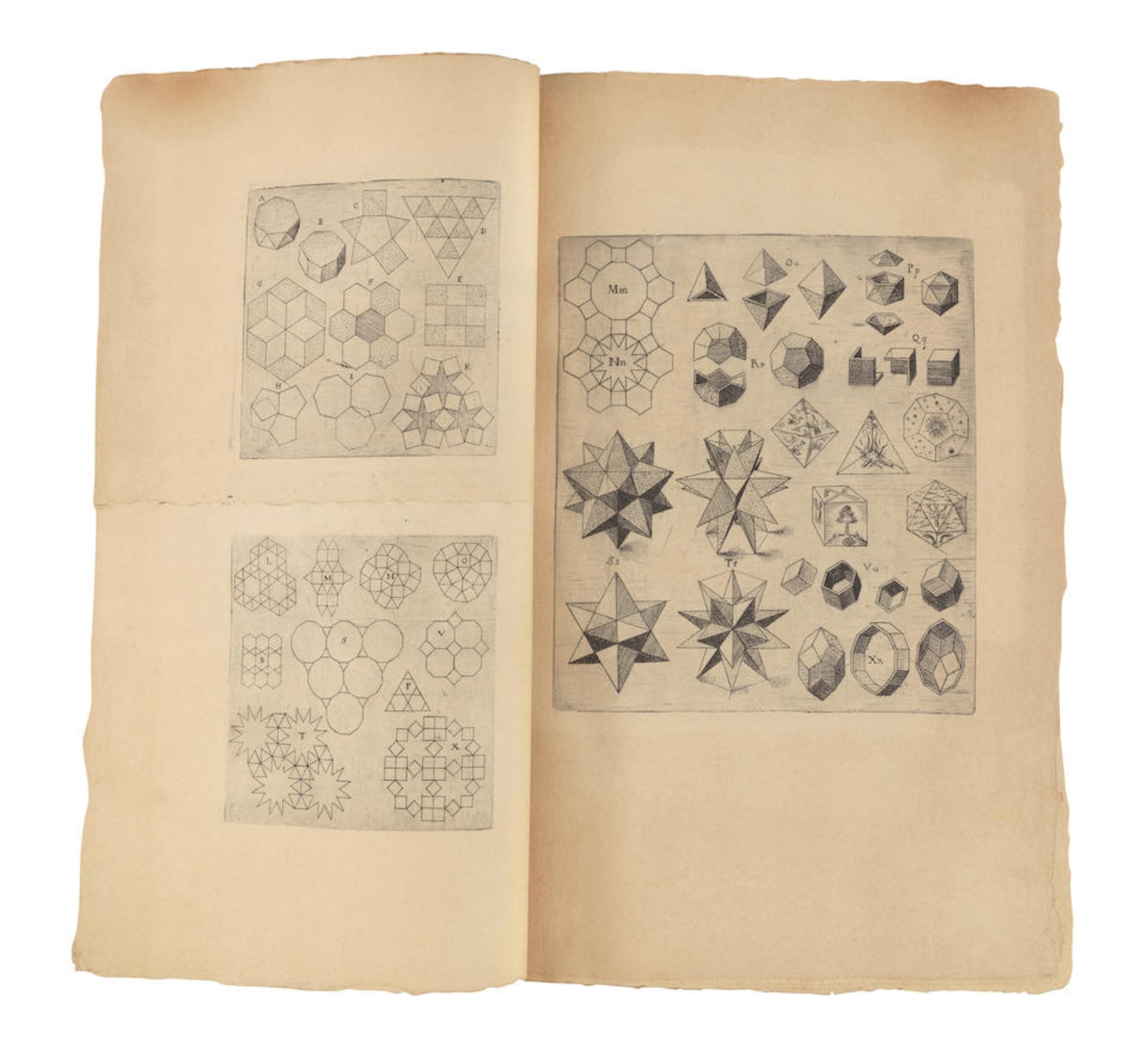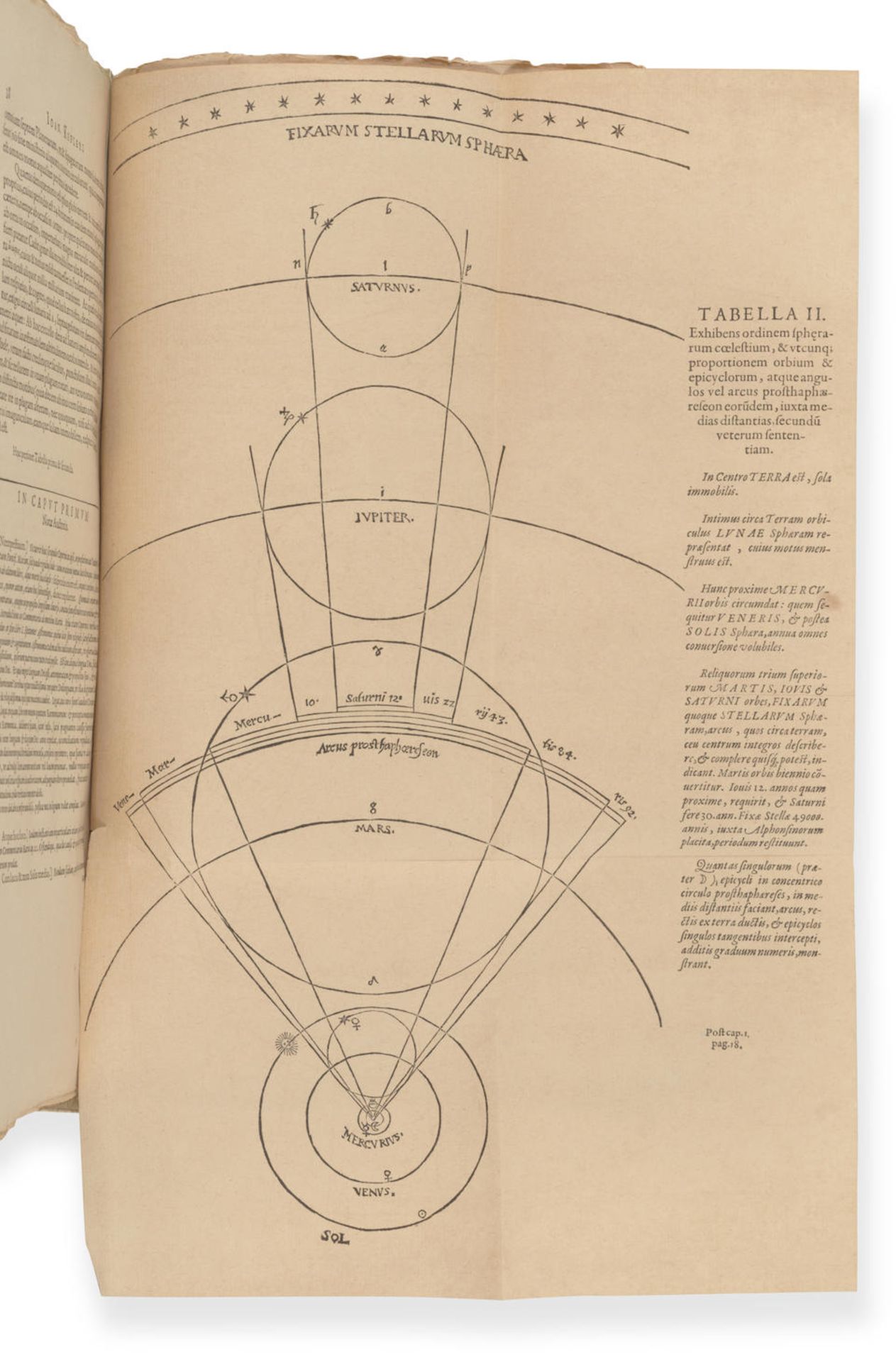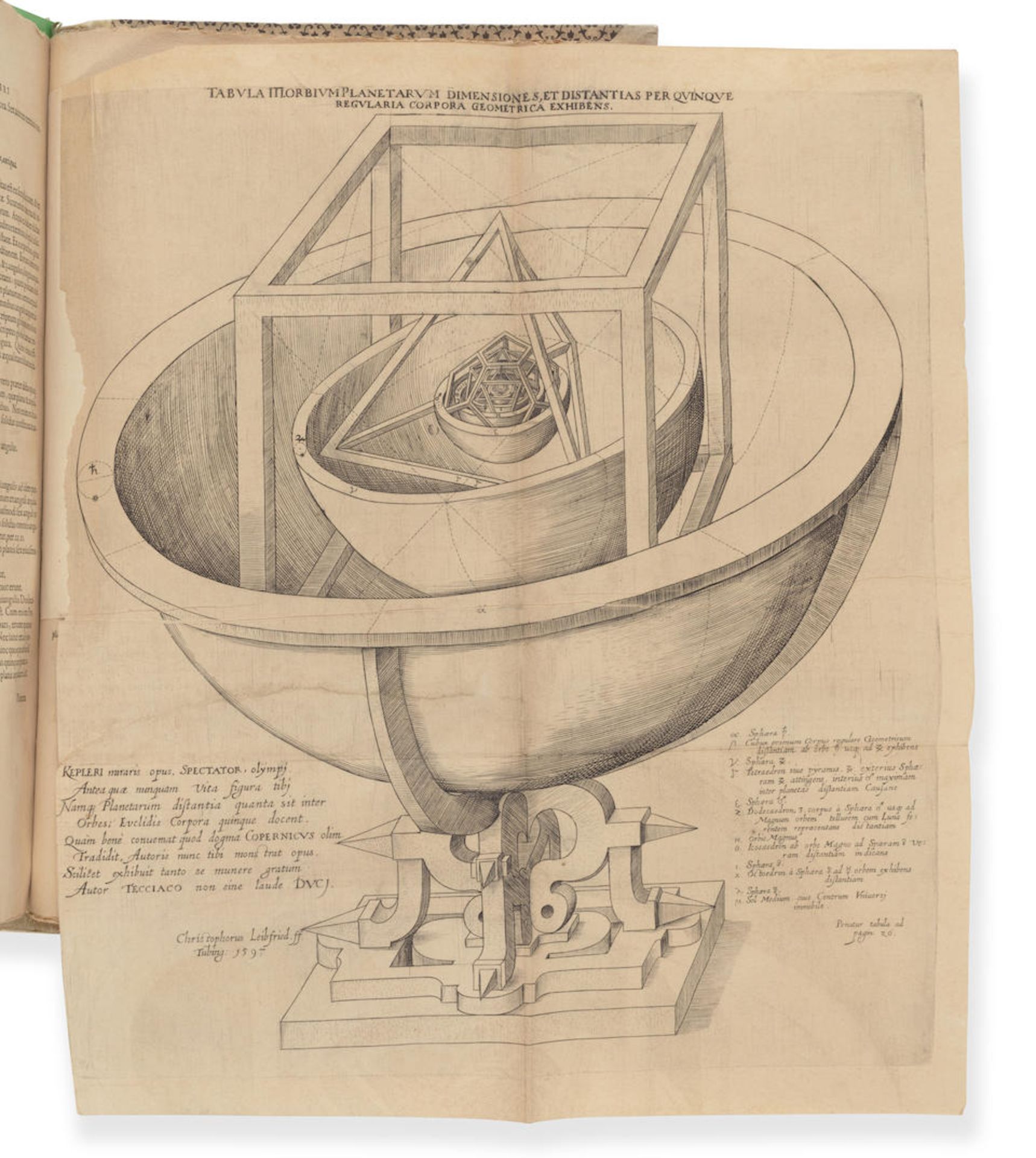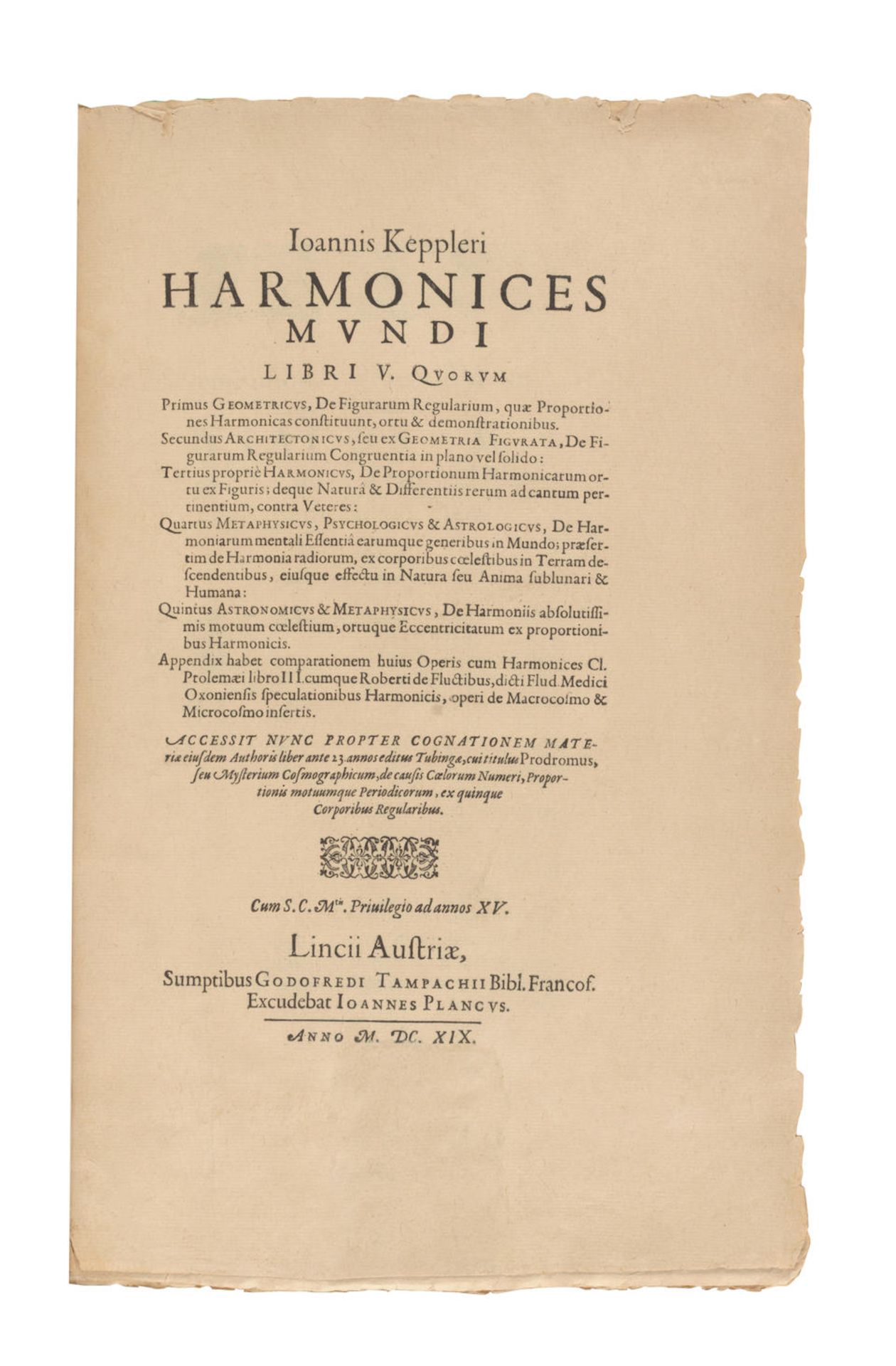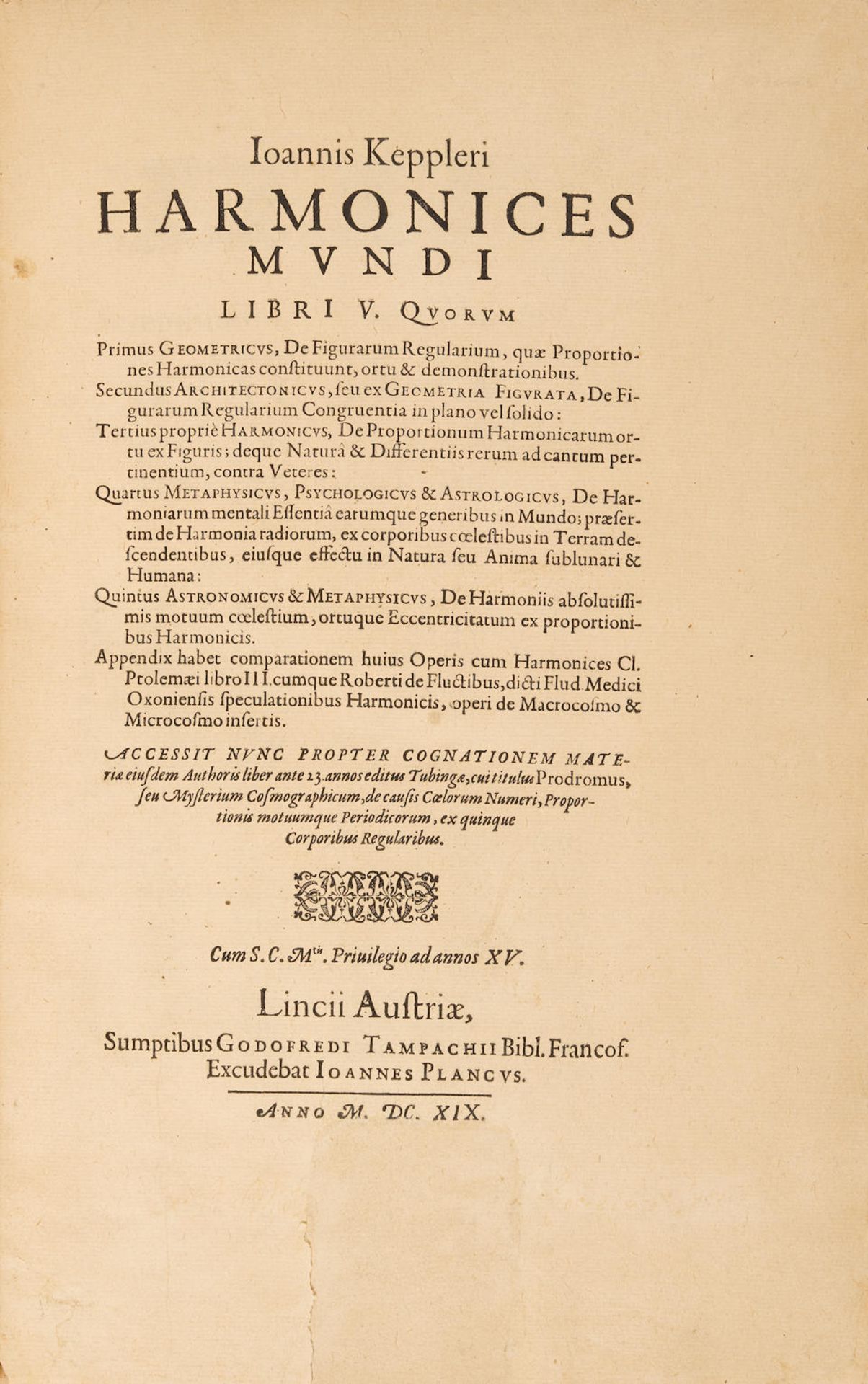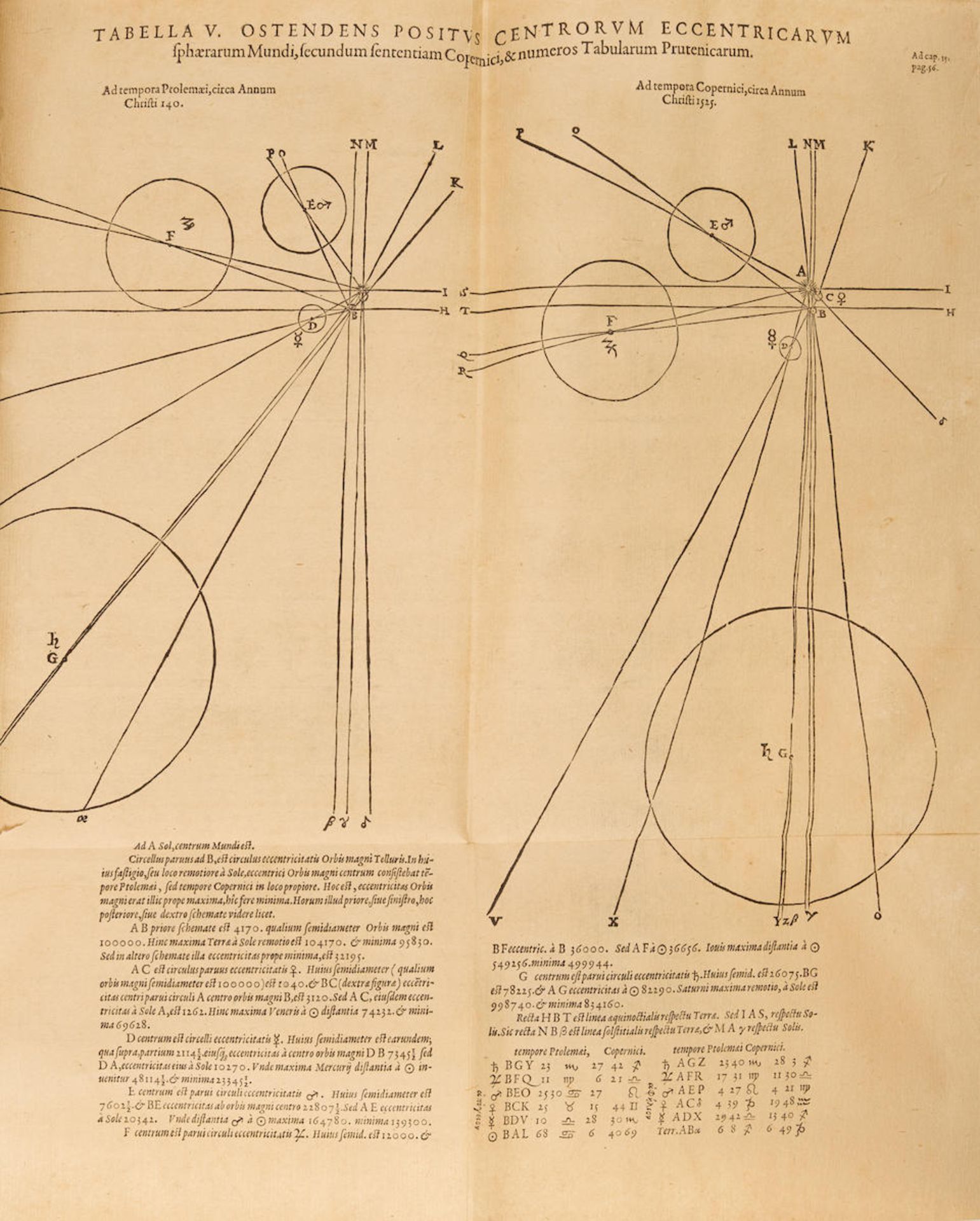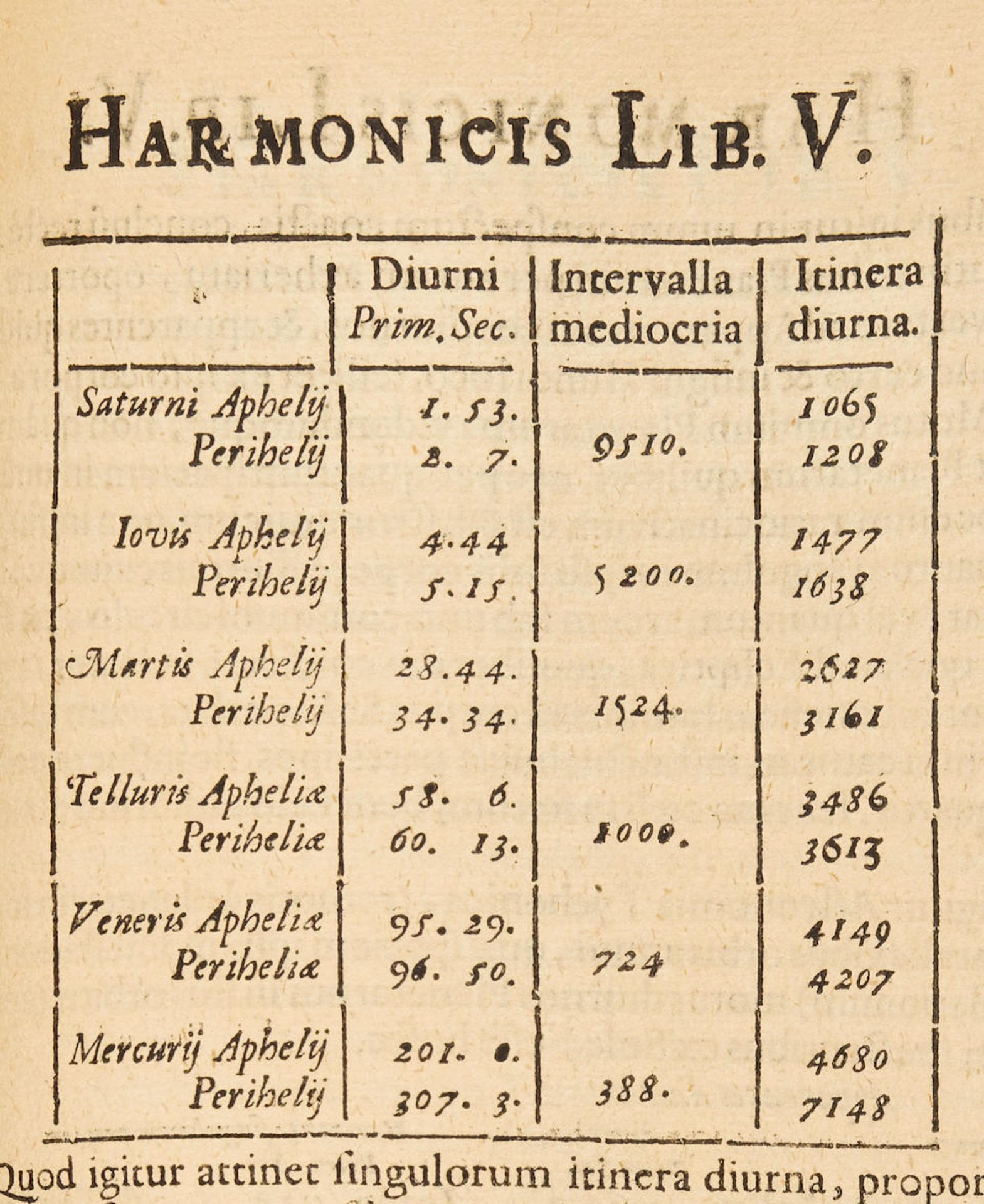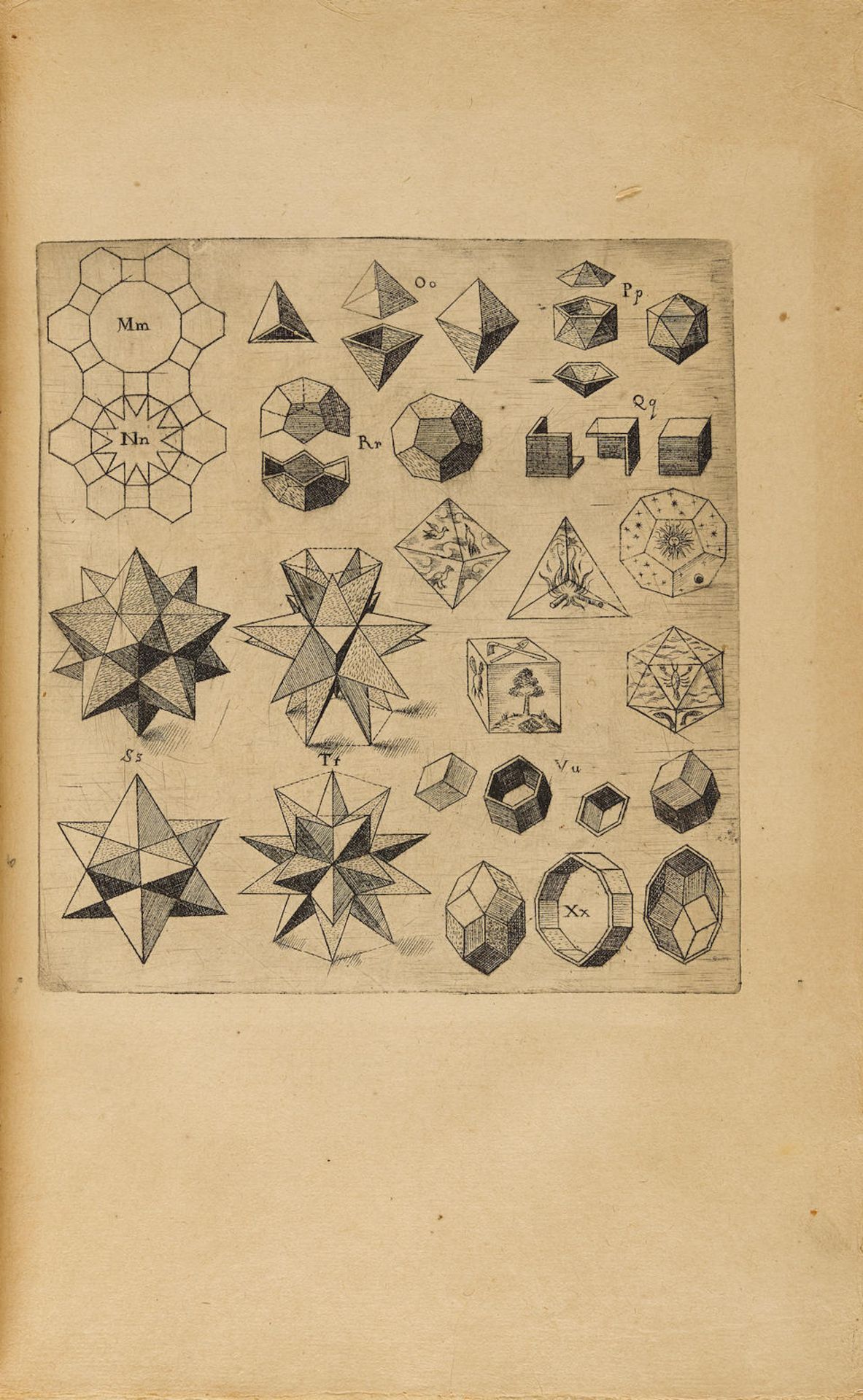9
KEPLER, JOHANNES. 1571-1630. Harmonices mundi libri V. Linz: Johann Planck for Gottfried Tampa...
KEPLER, JOHANNES. 1571-1630. Harmonices mundi libri V. Linz: Johann Planck for Gottfried Tampach, 1619. [BOUND WITH:] Prodromus Dissertationum Cosmographicarum, continens Mysterium Cosmographicum de admirabili proportione orbium coelestium. [AND:] Pro suo opere Harmonices Mundi Apologia. Frankfurt: Erasmus Kempfer for Gottfried Tampach, 1621-1622. 3 works in one volume, folio (Harmonices 325 x 205 mm; Prodromus 345 x 210 mm), all ENTIRELY UNCUT with deckled edges; Harmonices: general title in second state (with typographic ornament and with the text beginning 'Accessit nunc...'), with the dedication to King James of England *2r-*4r (later suppressed by Kepler and absent from some copies), 5 sectional titles, errata leaf at end; 6 engraved plates, numerous woodcut illustrations and diagrams in text, woodcut musical notation in Book III; stamp removed from title and final leaf, minor marginal repair to a couple of leaves, light even browning to the paper. Prodromus Dissertationum and Pro suo opere Harmonices: with separate dated title page: one engraved folding plate, 4 woodcut plates and woodcut diagram; closed marginal tear to F1, engraved folding plate with paper repairs to verso and mounted on a stub, light even browning to the paper, darkening to upper page edges near fore-edge, running into margins of first half of book, bound without final blank. The three works bound together, vellum-backed decorative boards. Provenance: evidence of removed stamps from title and final leaf of first work; Brixen ('Ex Coll. Brix' washed 17th-century ink presentation inscription on final verso of last work, woodcut label; Giancarlo Beltrame, sold his sale, Christies, London, July 13, 2016, lot 67. 'Before Kepler, all men were blind. Kepler had one eye, Newton had two.' —Voltaire A RARE UNCUT COPY OF KEPLER'S MAGNUM OPUS, PRONOUNCING HIS THIRD LAW OF PLANETARY MOTION, ONE OF THE FOUNDATIONAL ACHIEVEMENTS OF EARLY MODERN SCIENCE. THE CULMINATION OF A LIFELONG EFFORT TO DISCERN THE PATTERN OF THE UNIVERSE, Kepler's Harmonices Mundi is a sweeping meditation on mathematics, music, and the stars. Fueled by an unshakeable Pythagorean conviction that the universe was constructed on harmonic principles, the work begins with purely mathematical considerations and advances upwards through musical theory to the Heavens—ultimately reaching its crescendo in the first public pronouncement of Kepler's Third Law of Planetary Motion: the square of the period of revolution of a planet about the sun is proportional to the cube of the mean distance of the planet from the sun, A3= P2. A scientific masterwork, Harmonices Mundi represents a critical victory for scientific thought and method. Acknowledged as one of the most important and elegant equations in all of science, Kepler's Third Law was the first major modern scientific law deduced from empirical data. Many scholars consider the 'Keplerian revolution' to be the true beginning of modern science. Johannes Kepler is one of the primary 'giants' on whose shoulders Newton stood. Kepler's Third Law was in fact the mathematical springboard for Isaac Newton's discovery and articulation of the generalized laws of motion and gravity. Though Kepler had a 'presentiment' of gravity—though he believed that planetary motion was determined by a real energy emanating from the Sun—Kepler himself was unable to explain the actual force at work. This task was left to Newton, who addresses Kepler's laws at multiple places within the Principia. In the course of developing his own theory, Newton generalized Kepler's law to apply to any two bodies orbiting a common center of mass and he further showed that it was derivable from his own three laws of Motion and his law of universal gravitation. Kepler's grand synthesis of harmonic ratios in Harmonices Mundi concludes the research program he had begun in his first published book, Mysterium Cosmographicum (1596). 'The first unabashedly Copernican treatise since De Revolutionibus itself,' the Mysterium 'established [Kepler] as the first and until Descartes the only, scientist to demand physical explanations for celestial phenomena' (DSB). In Harmonices, Kepler writes, 'Again, therefore, a part of my Secret of the Universe, put in suspense 22 years ago because it was not yet clear, is to be completed here, and brought in at this point... I first believed I was dreaming,' before revealing his derivation of his harmonic law. Containing the alpha and the omega of Kepler's life work, the present copy contains the untrimmed Harmonices Mundi bound with an untrimmed copy of the 1621 edition of the Mysterium Cosmographicum (2nd edition, revised) and the 1622 first printing of the Pro Suo Opere Harmonices, Kepler's defense of his work against Robert Fludd's critique. The dimensions of this copy of the Mysterium/Pro Suo in fact exceed anything recorded by OCLC. Complete, large copies of Harmonices Mundi have become increasingly rare, and no other uncut copies are known to have appeared at auction in the last 40 years. A BEAUTIFUL EXAMPLE OF A MILESTONE OF SCIENTIFIC THOUGHT. Harmonices: Caspar 58; Dibner Heralds of Science 6; Grolier/Horblit 58; Houzeau and Lancaster 11832; Norman 1207. Mysterium Cosmographicum and Pro suo opere Harmonices: Caspar 67-68; Houzeau and Lancaster 2841 and 11833. All three works: Milestones of Science 115. See PMM 112. This lot is subject to the following lot symbols: ▲ ▲ 'Bonhams' owns the 'Lot' either wholly or partially or may otherwise have an economic interest. For further information on this lot please visit Bonhams.com For further information about this lot please visit the lot listing
KEPLER, JOHANNES. 1571-1630. Harmonices mundi libri V. Linz: Johann Planck for Gottfried Tampach, 1619. [BOUND WITH:] Prodromus Dissertationum Cosmographicarum, continens Mysterium Cosmographicum de admirabili proportione orbium coelestium. [AND:] Pro suo opere Harmonices Mundi Apologia. Frankfurt: Erasmus Kempfer for Gottfried Tampach, 1621-1622. 3 works in one volume, folio (Harmonices 325 x 205 mm; Prodromus 345 x 210 mm), all ENTIRELY UNCUT with deckled edges; Harmonices: general title in second state (with typographic ornament and with the text beginning 'Accessit nunc...'), with the dedication to King James of England *2r-*4r (later suppressed by Kepler and absent from some copies), 5 sectional titles, errata leaf at end; 6 engraved plates, numerous woodcut illustrations and diagrams in text, woodcut musical notation in Book III; stamp removed from title and final leaf, minor marginal repair to a couple of leaves, light even browning to the paper. Prodromus Dissertationum and Pro suo opere Harmonices: with separate dated title page: one engraved folding plate, 4 woodcut plates and woodcut diagram; closed marginal tear to F1, engraved folding plate with paper repairs to verso and mounted on a stub, light even browning to the paper, darkening to upper page edges near fore-edge, running into margins of first half of book, bound without final blank. The three works bound together, vellum-backed decorative boards. Provenance: evidence of removed stamps from title and final leaf of first work; Brixen ('Ex Coll. Brix' washed 17th-century ink presentation inscription on final verso of last work, woodcut label; Giancarlo Beltrame, sold his sale, Christies, London, July 13, 2016, lot 67. 'Before Kepler, all men were blind. Kepler had one eye, Newton had two.' —Voltaire A RARE UNCUT COPY OF KEPLER'S MAGNUM OPUS, PRONOUNCING HIS THIRD LAW OF PLANETARY MOTION, ONE OF THE FOUNDATIONAL ACHIEVEMENTS OF EARLY MODERN SCIENCE. THE CULMINATION OF A LIFELONG EFFORT TO DISCERN THE PATTERN OF THE UNIVERSE, Kepler's Harmonices Mundi is a sweeping meditation on mathematics, music, and the stars. Fueled by an unshakeable Pythagorean conviction that the universe was constructed on harmonic principles, the work begins with purely mathematical considerations and advances upwards through musical theory to the Heavens—ultimately reaching its crescendo in the first public pronouncement of Kepler's Third Law of Planetary Motion: the square of the period of revolution of a planet about the sun is proportional to the cube of the mean distance of the planet from the sun, A3= P2. A scientific masterwork, Harmonices Mundi represents a critical victory for scientific thought and method. Acknowledged as one of the most important and elegant equations in all of science, Kepler's Third Law was the first major modern scientific law deduced from empirical data. Many scholars consider the 'Keplerian revolution' to be the true beginning of modern science. Johannes Kepler is one of the primary 'giants' on whose shoulders Newton stood. Kepler's Third Law was in fact the mathematical springboard for Isaac Newton's discovery and articulation of the generalized laws of motion and gravity. Though Kepler had a 'presentiment' of gravity—though he believed that planetary motion was determined by a real energy emanating from the Sun—Kepler himself was unable to explain the actual force at work. This task was left to Newton, who addresses Kepler's laws at multiple places within the Principia. In the course of developing his own theory, Newton generalized Kepler's law to apply to any two bodies orbiting a common center of mass and he further showed that it was derivable from his own three laws of Motion and his law of universal gravitation. Kepler's grand synthesis of harmonic ratios in Harmonices Mundi concludes the research program he had begun in his first published book, Mysterium Cosmographicum (1596). 'The first unabashedly Copernican treatise since De Revolutionibus itself,' the Mysterium 'established [Kepler] as the first and until Descartes the only, scientist to demand physical explanations for celestial phenomena' (DSB). In Harmonices, Kepler writes, 'Again, therefore, a part of my Secret of the Universe, put in suspense 22 years ago because it was not yet clear, is to be completed here, and brought in at this point... I first believed I was dreaming,' before revealing his derivation of his harmonic law. Containing the alpha and the omega of Kepler's life work, the present copy contains the untrimmed Harmonices Mundi bound with an untrimmed copy of the 1621 edition of the Mysterium Cosmographicum (2nd edition, revised) and the 1622 first printing of the Pro Suo Opere Harmonices, Kepler's defense of his work against Robert Fludd's critique. The dimensions of this copy of the Mysterium/Pro Suo in fact exceed anything recorded by OCLC. Complete, large copies of Harmonices Mundi have become increasingly rare, and no other uncut copies are known to have appeared at auction in the last 40 years. A BEAUTIFUL EXAMPLE OF A MILESTONE OF SCIENTIFIC THOUGHT. Harmonices: Caspar 58; Dibner Heralds of Science 6; Grolier/Horblit 58; Houzeau and Lancaster 11832; Norman 1207. Mysterium Cosmographicum and Pro suo opere Harmonices: Caspar 67-68; Houzeau and Lancaster 2841 and 11833. All three works: Milestones of Science 115. See PMM 112. This lot is subject to the following lot symbols: ▲ ▲ 'Bonhams' owns the 'Lot' either wholly or partially or may otherwise have an economic interest. For further information on this lot please visit Bonhams.com For further information about this lot please visit the lot listing
























